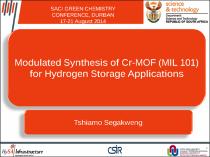JavaScript is disabled for your browser. Some features of this site may not work without it.
- ResearchSpace
- →
- Research Publications/Outputs
- →
- Conference Publications
- →
- View Item
| dc.contributor.author |
Segakweng, T

|
|
| dc.date.accessioned | 2015-11-20T12:16:17Z | |
| dc.date.available | 2015-11-20T12:16:17Z | |
| dc.date.issued | 2014-08 | |
| dc.identifier.citation | Segakweng, T. 2014. Modulated synthesis of Cr-MOF (MIL 101) for hydrogen storage applications. In: SACI Green Chemistry Confrence, Durban, South Africa, 17-21 August 2014 | en_US |
| dc.identifier.uri | http://hdl.handle.net/10204/8297 | |
| dc.description | SACI Green Chemistry Confrence, Durban, South Africa, 17-21 August 2014 | en_US |
| dc.description.abstract | With the increasing environmental pressures, alternative sources of energy are required. Hydrogen has long been considered to be an ideal alternative to fossil fuel system owing to its elimination of greenhouse gasses. Complete usage of hydrogen as a fuel into fuel cell technologies is only possible when safe and effective hydrogen storage systems become available. Complete usage of hydrogen is only possible if proper and effective storage systems with fast kinetics becomes available. Porous material-based adsorptive storage, hydrogen gas as an adsorbed species within a suitable porous adsorbent such as metal organic frameworks (MOFs), continue to attract an increasing attention as a long-term solution to meet stringent volumetric targets and offer low-pressure hydrogen storage [1]. Among the various MOFs materials, Chromium-based MOF (MIL-101) has shown to pose high surface area, good stability and comparable hydrogen storage capacities. However, its current synthesis procedure incudes the use of very toxic and dangerous chemicals such as Hydrofluoric acid (HF)[2]. In this work, MIL-101 crystals with high crystallinity and well-defined shapes were synthesised using water as solvent and small amount of formic acid as modulator. The obtained MIL-101 products showed excellent hydrostability, high porosity and big surface area, making it particularly suitable for practical hydrogen storage applications. The synthesis procedure employed in this study has also been proved to be a far safer way of synthesising MIL 101 with properties comparable to those of MIL-101 synthesised when using HF as the modulator. | en_US |
| dc.language.iso | en | en_US |
| dc.relation.ispartofseries | Workflow;14966 | |
| dc.subject | Chromium-based metal-organic framework | en_US |
| dc.subject | Hydrostability | en_US |
| dc.subject | Hydrogen adsorption | en_US |
| dc.subject | Hydrofluoric Acid | en_US |
| dc.subject | Formic Acid | en_US |
| dc.subject | Modulated synthesis | en_US |
| dc.subject | Hydrogen storage applications | en_US |
| dc.title | Modulated synthesis of Cr-MOF (MIL 101) for hydrogen storage applications | en_US |
| dc.type | Conference Presentation | en_US |
| dc.identifier.apacitation | Segakweng, T. (2014). Modulated synthesis of Cr-MOF (MIL 101) for hydrogen storage applications. http://hdl.handle.net/10204/8297 | en_ZA |
| dc.identifier.chicagocitation | Segakweng, T. "Modulated synthesis of Cr-MOF (MIL 101) for hydrogen storage applications." (2014): http://hdl.handle.net/10204/8297 | en_ZA |
| dc.identifier.vancouvercitation | Segakweng T, Modulated synthesis of Cr-MOF (MIL 101) for hydrogen storage applications; 2014. http://hdl.handle.net/10204/8297 . | en_ZA |
| dc.identifier.ris | TY - Conference Presentation AU - Segakweng, T AB - With the increasing environmental pressures, alternative sources of energy are required. Hydrogen has long been considered to be an ideal alternative to fossil fuel system owing to its elimination of greenhouse gasses. Complete usage of hydrogen as a fuel into fuel cell technologies is only possible when safe and effective hydrogen storage systems become available. Complete usage of hydrogen is only possible if proper and effective storage systems with fast kinetics becomes available. Porous material-based adsorptive storage, hydrogen gas as an adsorbed species within a suitable porous adsorbent such as metal organic frameworks (MOFs), continue to attract an increasing attention as a long-term solution to meet stringent volumetric targets and offer low-pressure hydrogen storage [1]. Among the various MOFs materials, Chromium-based MOF (MIL-101) has shown to pose high surface area, good stability and comparable hydrogen storage capacities. However, its current synthesis procedure incudes the use of very toxic and dangerous chemicals such as Hydrofluoric acid (HF)[2]. In this work, MIL-101 crystals with high crystallinity and well-defined shapes were synthesised using water as solvent and small amount of formic acid as modulator. The obtained MIL-101 products showed excellent hydrostability, high porosity and big surface area, making it particularly suitable for practical hydrogen storage applications. The synthesis procedure employed in this study has also been proved to be a far safer way of synthesising MIL 101 with properties comparable to those of MIL-101 synthesised when using HF as the modulator. DA - 2014-08 DB - ResearchSpace DP - CSIR KW - Chromium-based metal-organic framework KW - Hydrostability KW - Hydrogen adsorption KW - Hydrofluoric Acid KW - Formic Acid KW - Modulated synthesis KW - Hydrogen storage applications LK - https://researchspace.csir.co.za PY - 2014 T1 - Modulated synthesis of Cr-MOF (MIL 101) for hydrogen storage applications TI - Modulated synthesis of Cr-MOF (MIL 101) for hydrogen storage applications UR - http://hdl.handle.net/10204/8297 ER - | en_ZA |






